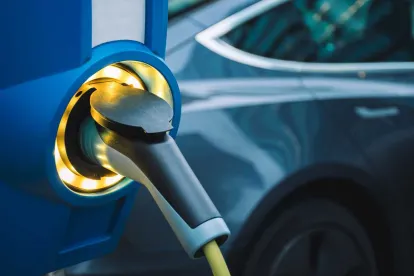On Monday, December 12, 2022, the IRS released Revenue Procedure 2022-42 (the “EV Guidance”), which sets forth reporting requirements for manufacturers and sellers of new or previously owned clean vehicles or qualified new commercial clean vehicles that are eligible for tax credits under Internal Revenue Code Sections 30D, 25E, or 45W, respectively.[1] The EV Guidance provides needed details for implementing changes made by the Inflation Reduction Act of 2022 (the “IRA”).
The issuance of guidance for manufacturers is especially important because, in most cases, these tax credits are only available if the manufacturer enters into a written agreement to periodically provide certain written reports to the IRS (defined as a “qualified manufacturer” in Section 30D(3)).[2] The EV Guidance describes the procedures related to such written agreement and the specific content to include in the written reports for the three categories of vehicles. The EV Guidance also sets forth the information that is required to be included in reports required to be filed with the IRS and given to taxpayers by sellers of vehicles eligible for tax credits under Sections 30D or 25E.
Notably, the EV Guidance does not address the new critical minerals and battery component requirements that the IRA added to the tax credit for new clean vehicles under Section 30D. These requirements will be addressed in separate guidance, which is required to be issued by December 31 of this year.
Manufacturer Reports
A vehicle manufacturer becomes a qualified manufacturer by sending its signed written agreement to provide the required periodic reports to IRS.Clean.Vehicle.Manufacturers@irs.gov and then will be required to file monthly reports. Instructions for submitting the reports will be provided by the IRS following receipt of an email from the qualified manufacturer to IRS.Clean.Vehicles.QM.Reporting@irs.gov indicating the manufacturer’s intent to file monthly reports.
Each monthly report must be signed by an authorized person who certifies that it is true, accurate, and complete under penalties of perjury. Some of the information is the same for all three tax credits, and other information is tailored to the statutory requirements of the specific tax credit.
All manufacturer reports must include the following:
-
Vehicle make, model, and year.
-
Certification that the vehicle was made by a qualified manufacturer.
-
Certification of status as a motor vehicle for purposes of title II of the Clean Air Act.
-
Gross vehicle weight rating.
-
Battery capacity.
-
Vehicle identification number (VIN).
-
Any other information required by the Secretary, as provided on irs.gov.
The following certifications need to be added to manufacturer reports based on the applicable tax credit.
Section 30D – New Clean Vehicles
-
The vehicle is either (i) propelled to a significant extent by an electric motor with a battery that has at least 7 kWh capacity and can be recharged by an external source, or (ii) is a new qualified fuel cell motor vehicle (as defined in Section 30B(b)(3)).
-
The vehicle is primarily for use on public streets, roads, and highways (not including a vehicle operated exclusively on a rail or rails) and has at least four wheels.
-
Final assembly occurred within North America.
-
Identification of the vehicle as either a van, sport utility vehicle, pickup truck, or other vehicle.
-
The manufacturer’s suggested retail price.
-
The value of the critical minerals contained in the battery that were (i) extracted or processed in the United States, or in any country with which the United States has a free trade agreement, or (ii) recycled in North America.[3]
-
The percentage of the value of the components contained in the battery that were manufactured or assembled in North America.[4]
Section 25 – Previously Owned Clean Vehicles[5]
-
The vehicle is either (i) propelled to a significant extent by an electric motor with a battery that has at least 7 kWh capacity and can be recharged by an external source, or (ii) is a new qualified fuel cell motor vehicle that satisfies the requirements under Section 30B(b)(3)(A) and (B) and has a gross vehicle weight rating of less than 14,000 pounds.
-
The vehicle is primarily for use on public streets, roads, and highways (not including a vehicle operated exclusively on a rail or rails) and has at least four wheels.
Section 45W – Commercial Clean Vehicles
For motor vehicles:
-
The vehicle is primarily for use on public streets, roads, and highways (not including a vehicle operated exclusively on a rail or rails).
-
The vehicle is either (i) propelled to a significant extent by an electric motor with a battery that has at least 15 kWh capacity (or, in the case of a vehicle with a gross vehicle weight rating of less than 14,000 pounds, 7 kWh) and can be recharged from an external source, or (ii) is a new qualified fuel cell motor vehicle that satisfies the requirements under Section 30B(b)(3)(A) and (B).
-
If the vehicle has a gross vehicle weight rating of less than 14,000 pounds, the manufacturer’s suggested retail price.
For mobile machinery:
-
The machinery meets the definition in Section 4053(8) (including vehicles that are not designed to perform the function of transporting a load over public highways).
-
The machinery is either (i) propelled to a significant extent by an electric motor with a battery that has at least 15 kWh capacity (or, in the case of a vehicle with a gross vehicle weight rating of less than 14,000 pounds, 7 kWh) and can be recharged from an external source, or (ii) is a new qualified fuel cell motor vehicle that satisfies the requirements under Section 30B(b)(3)(A) and (B).
Seller Reports
Sellers of new and previously owned clean vehicles eligible for the tax credit under Section 30D or 25E, respectively, are required to file reports with the IRS within 15 days after the end of the calendar year for vehicles sold after 2022 (i.e., the first reports will be due on January 15, 2024) and also provide the purchaser with such information at the time of sale. The required information is as follows:
-
The name and taxpayer identification number (TIN) of the seller.
-
The name and TIN of the taxpayer.
-
The VIN, if applicable.
-
The battery capacity.
-
For new clean vehicles, verification that the original use of the vehicle commences with the taxpayer.
-
Date of sale, sales price, maximum allowed credit under Section 30D or 25E, as applicable.
-
For sales after 2023, if the taxpayer elects to transfer the credit to an eligible dealer under Section 30D(g)(1), the amount paid or otherwise allowed as a partial payment or down payment to the taxpayer.
* * * * * *
Endnotes
[1] Unless otherwise stated, capitalized references to “Section” are to the Internal Revenue Code of 1986, as amended (the “Code”).
[2] This requirement does not apply to certain clean vehicles powered by fuel cells for purposes of the Section 30D tax credit or the Section 25E tax credit.
[3] This requirement is not active until the IRS issues separate proposed guidance pursuant to Section 30D(e)(3)(B) on valuing critical minerals.
[4] This requirement is not active until the IRS issues separate proposed guidance pursuant to Section 30D(e)(3)(B) on valuing battery components.
[5] These additional certifications are required to the extent not previously provided in a report for such motor vehicle for purposes of Section 30D or Section 45W.





 />i
/>i
